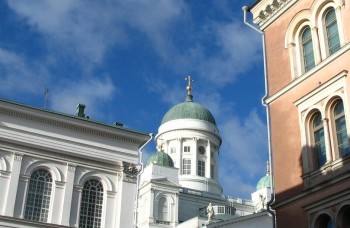Books from Helsinki
30 June 2013 | This 'n' that

Helsinki: view it from different angles! Photo: Leena Lahti
Helsinki is relatively young city, Finnish literature even younger.
Flushed with a huge wave of migration at the beginning of the 20th century, the capital and its people went through the dramatic times of gaining independence and the Civil War (1917–18). The capital – since 1812 – and the life experiences of its inhabitants have been plentifully featured in Finnish fiction.
In his doctoral dissertation, Lieven Ameel has concentrated on a period of Finnish literary history. His Moved by the City: Experiences of Helsinki in Finnish Prose Fiction 1889–1941 (2013, Department of Finnish, Finno-Ugrian and Scandinavian Studies, University of Helsinki) examines more than sixty novels, collections of short stories and individual short stories portraying the city: how do the characters experience this urban public space? (Popular – crime fiction, for example – and children’s literature are excluded.)
‘This period constitutes what is in effect the first half century of literary representations of Helsinki in Finnish-written literature, starting with the very first texts thematizing the Finnish capital (Juhani Aho’s Helsinkiin (‘To Helsinki’, 1889) [–] and ending with the disruption caused by the Second World War.’ Ameel argues ‘that around the turn of the twentieth century, literary Helsinki was approached from a surprisingly rich variety of generic and thematic perspectives which were in close dialogue with international contemporary traditions and age-old images of the city, and defined by events typical of Helsinki’s own history.’ Among the authors he discusses are Arvid Järnefelt, Maila Talvio, Mika Waltari, Joel Lehtonen and Helvi Hämäläinen.
In our book Helsinki: a literary companion, compiled and edited to celebrate the 450th anniversary of the capital in 2000, Aho’s novel Helsinkiin (‘To Helsinki’, 1889) was the first text written in Finnish that we featured.
Ameel concludes: ‘In prose texts that appear during the first decades of the twentieth century, Helsinki is experienced as a space in motion. The Finnish capital is depicted as an expanding and transforming city [–]. ‘The socio-political conditions particular to Helsinki in the early decades of the twentieth century infuse the literature of the Finnish capital with an unmistakable and distinct atmosphere, setting it apart from other contemporary literary cities. Other elements, too, can be singled out as distinct for literary Helsinki in the early twentieth century. Apart from a few exceptions to confirm the rule, most literary characters in Helsinki novels in Finnish in the period 1889–1919 are outsiders to the capital [–].
Ameel notes that in the 1920s and 130s the ‘urban experience is increasingly aestheticized and internalized. [–] New city districts assume the role of central environments in the city novels and prose stories during these decades, and the importance of the city centre gradually diminishes.’
Helsinki: a literary companion includes Helsinki literature written in other languages (Swedish, Russian, French and English) by both native and foreign writers as well as non-fiction and poetry from the 1820s to the 1990s. In the literary samples from the second half of the 21st century the city expands further: suburban experiences of the writers and the characters become part of the Helsinki story, ever changing.
….You are no more, there’s stone, iron, steel
there’s a new city of brick, glass and cement on your grave, old Rööperi
There’s a city stippled with seagulls, clouds, trails of smoke
there’s a city reflecting its face in the sea water
ever and always making its face anew.
(Arvo Turtiainen’s poem from Minä paljasjalkainen, ‘I was born here‘, 1962; translated by Herbert Lomas, published in Helsinki: a literary companion; The Finnish Literature Society, 2000)
Tags: classics, cultural history, Helsinki, literary history
No comments for this entry yet
